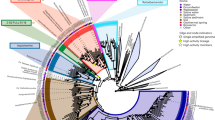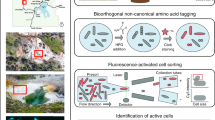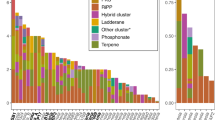Abstract
Next-generation DNA sequencing and metagenomic analysis provide powerful tools for the environmentally friendly design of nanoparticles. Herein we demonstrate this approach using a model community of environmental microbes (that is, wastewater-activated sludge) dosed with gold nanoparticles of varying surface coatings and morphologies. Metagenomic analysis was highly sensitive in detecting the microbial community response to gold nanospheres and nanorods with either cetyltrimethylammonium bromide or polyacrylic acid surface coatings. We observed that the gold-nanoparticle morphology imposes a stronger force in shaping the microbial community structure than does the surface coating. Trends were consistent in terms of the compositions of both taxonomic and functional genes, which include antibiotic resistance genes, metal resistance genes and gene-transfer elements associated with cell stress that are relevant to public health. Given that nanoparticle morphology remained constant, the potential influence of gold dissolution was minimal. Surface coating governed the nanoparticle partitioning between the bioparticulate and aqueous phases.
This is a preview of subscription content, access via your institution
Access options
Access Nature and 54 other Nature Portfolio journals
Get Nature+, our best-value online-access subscription
$29.99 / 30 days
cancel any time
Subscribe to this journal
Receive 12 print issues and online access
$259.00 per year
only $21.58 per issue
Buy this article
- Purchase on Springer Link
- Instant access to full article PDF
Prices may be subject to local taxes which are calculated during checkout





Similar content being viewed by others
References
Steffen, W. et al. Planetary boundaries: guiding human development on a changing planet. Science 347, 1259855 (2015).
Gottschalk, F., Sonderer, T., Scholz, R. W. & Nowack, B. Modeled environmental concentrations of engineered nanomaterials (TiO2, ZnO, Ag, CNT, fullerenes) for different regions. Environ. Sci. Technol. 43, 9216–9222 (2009).
Mahapatra, I. et al. Probabilistic modelling of prospective environmental concentrations of gold nanoparticles from medical applications as a basis for risk assessment. J. Nanobiotechnol. 13, 93 (2015).
Schimel, J., Balser, T. C. & Wallenstein, M. Microbial stress-response physiology and its implications for ecosystem function. Ecology 88, 1386–1394 (2007).
Briones, A. & Raskin, L. Diversity and dynamics of microbial communities in engineered environments and their implications for process stability. Curr. Opin. Biotechnol. 14, 270–276 (2003).
Zhang, T., Shao, M. F. & Ye, L. 454 pyrosequencing reveals bacterial diversity of activated sludge from 14 sewage treatment plants. ISME J. 6, 1137–1147 (2012).
Grady, C. L. Jr, Daigger, G. T., Love, N. G. & Filipe, C. D. Biological Wastewater Treatment (CRC, Boca Raton, FL,, 2011).
Hajipour, M. J. et al. Antibacterial properties of nanoparticles. Trends Biotechnol. 30, 499–511 (2012).
Ma, Y. et al. Microbial community response of nitrifying sequencing batch reactors to silver, zero-valent iron, titanium dioxide and cerium dioxide nanomaterials. Water Res. 68, 87–97 (2015).
Yang, Y. et al. Pyrosequencing reveals higher impact of silver nanoparticles than Ag+ on the microbial community structure of activated sludge. Water Res. 48, 317–325 (2014).
Loman, N. J. et al. High-throughput bacterial genome sequencing: an embarrassment of choice, a world of opportunity. Nat. Rev. Microbiol. 10, 599–606 (2012).
Simon, C. & Daniel, R. Metagenomic analyses: past and future trends. Appl. Environ. Microbiol. 77, 1153–1161 (2011).
Suresh, A. K., Pelletier, D. A. & Doktycz, M. J. Relating nanomaterial properties and microbial toxicity. Nanoscale 5, 463–474 (2013).
Nel, A. E. et al. Understanding biophysicochemical interactions at the nano–bio interface. Nat. Mater. 8, 543–557 (2009).
Gorka, D. E. et al. Reducing environmental toxicity of silver nanoparticles through shape control. Environ. Sci. Technol. 49, 10093–10098 (2015).
El Badawy, A. M. et al. Surface charge-dependent toxicity of silver nanoparticles. Environ. Sci. Technol. 45, 283–287 (2011).
Pal, S., Tak, Y. K. & Song, J. M. Does the antibacterial activity of silver nanoparticles depend on the shape of the nanoparticle? A study of the Gram-negative bacterium Escherichia coli. Appl. Environ. Microbiol. 73, 1712–1720 (2007).
Tong, T. et al. Effects of material morphology on the phototoxicity of nano-TiO2 to bacteria. Environ. Sci. Technol. 47, 12486–12495 (2013).
Burns, J. M. et al. Surface charge controls the fate of Au nanorods in saline estuaries. Environ. Sci. Technol. 47, 12844–12851 (2013).
Ferry, J. L. et al. Transfer of gold nanoparticles from the water column to the estuarine food web. Nat. Nanotech. 4, 441–444 (2009).
Alkilany, A. M. & Murphy, C. J. Toxicity and cellular uptake of gold nanoparticles: What we have learned so far? J. Nanopart. Res. 12, 2313–2333 (2010).
Monopoli, M. P., Bombelli, F. B. & Dawson, K. A. Nanobiotechnology: nanoparticle coronas take shape. Nat. Nanotech. 6, 11–12 (2011).
Tenzer, S. et al. Rapid formation of plasma protein corona critically affects nanoparticle pathophysiology. Nat. Nanotech. 8, 772–781 (2013).
Kaegi, R. et al. Behavior of silver nanoparticles in a pilot wastewater treatment plant. Environ. Sci. Technol. 45, 3902–3908 (2011).
Keller, A. A. & Lazareva, A. Predicted releases of engineered nanomaterials: from global to regional to local. Environ. Sci. Technol. Lett. 1, 65–70 (2014).
Siripong, S. & Rittmann, B. E. Diversity study of nitrifying bacteria in full-scale municipal wastewater treatment plants. Water Res. 41, 1110–1120 (2007).
Tomlinson, T. G., Boon, A. G. & Trotman, C. N. Inhibition of nitrification in the activated sludge process of sewage disposal. J. Appl. Bacteriol. 29, 266–291 (1966).
Choi, O. & Hu, Z. Size dependent and reactive oxygen species related nanosilver toxicity to nitrifying bacteria. Environ. Sci. Technol. 42, 4583–4588 (2008).
Arnaout, C. L. & Gunsch, C. K. Impacts of silver nanoparticle coating on the nitrification potential of Nitrosomonas europaea. Environ. Sci. Technol. 46, 5387–5395 (2012).
Meyer, F. et al. The metagenomics RAST server—a public resource for the automatic phylogenetic and functional analysis of metagenomes. BMC Bioinformatics 9, 386 (2008).
Ju, F., Guo, F., Ye, L., Xia, Y. & Zhang, T. Metagenomic analysis on seasonal microbial variations of activated sludge from a full-scale wastewater treatment plant over 4 years. Environ. Microbiol. Rep. 6, 80–89 (2014).
Yang, C. et al. Phylogenetic diversity and metabolic potential of activated sludge microbial communities in full-scale wastewater treatment plants. Environ. Sci. Technol. 45, 7408–7415 (2011).
Pruden, A., Pei, R., Storteboom, H. & Carlson, K. H. Antibiotic resistance genes as emerging contaminants: studies in northern Colorado. Environ. Sci. Technol. 40, 7445–7450 (2006).
Baker-Austin, C., Wright, M. S., Stepanauskas, R. & McArthur, J. V. Co-selection of antibiotic and metal resistance. Trends Microbiol. 14, 176–182 (2006).
Ma, Y., Metch, J. W., Yang, Y., Pruden, A. & Zhang, T. Shift in antibiotic resistance gene profiles associated with nanosilver during wastewater treatment. FEMS Microbiol Ecol. 92, fiw022 (2016).
Poole, K. Stress responses as determinants of antimicrobial resistance in Gram-negative bacteria. Trends Microbiol. 20, 227–234 (2012).
Zhang, T., Zhang, X. X. & Ye, L. Plasmid metagenome reveals high levels of antibiotic resistance genes and mobile genetic elements in activated sludge. PLoS ONE 6, e26041 (2011).
Arango-Argoty, G. et al. MetaStorm: a public resource for customizable metagenomic annotation. PLoS ONE 11, e0162442 (2016).
McArthur, A. G. et al. The comprehensive antibiotic resistance database. Antimicrob. Agents Chemother. 57, 3348–3357 (2013).
Pal, C., Bengtsson-Palme, J., Rensing, C., Kristiansson, E. & Larsson, D. G. J. BacMet: antibacterial biocide and metal resistance genes database. Nucleic Acids Res. 42, 737–743 (2014).
Leplae, R., Lima-Mendez, G. & Toussaint, A. ACLAME: a classification of mobile genetic elements, update 2010. Nucleic Acids Res. 38, D57–D61 (2009).
Alkilany, A. M. et al. Cellular uptake and cytotoxicity of gold nanorods: molecular origin of cytotoxicity and surface effects. Small 5, 701–708 (2009).
González, S., Petrovic, M. & Barceló, D. Removal of a broad range of surfactants from municipal wastewater—Comparison between membrane bioreactor and conventional activated sludge treatment. Chemosphere 67, 335–343 (2007).
Zeng, G. et al. Co-digestion with glucose of four surfactants, CTAB, Triton X-100, SDS and Rhamnolipid, in liquid culture media and compost matrix. Biodegradation 18, 303–310 (2007).
Gagner, J. E., Lopez, M. D., Dordick, J. S. & Siegel, R. W. Effect of gold nanoparticle morphology on adsorbed protein structure and function. Biomaterials 32, 7241–7252 (2011).
Sisco, P. N. et al. Adsorption of cellular proteins to polyelectrolyte-functionalized gold nanorods: a mechanism for nanoparticle regulation of cell phenotype? 9, e86670 (2014).
Joshi, N., Ngwenya, B. T. & French, C. E. Enhanced resistance to nanoparticle toxicity is conferred by overproduction of extracellular polymeric substances. J. Hazard. Mater. 241, 363–370 (2012).
McSwain, B. S., Irvine, R. L., Hausner, M. & Wilderer, P. A. Composition and distribution of extracellular polymeric substances in aerobic flocs and granular sludge. Appl. Environ. Microbiol. 71, 1051–1057 (2005).
Center for Disease Control and Prevention. Antibiotic Resistance Threats in the United States (US Department of Health and Human Services, 2013); http://www.cdc.gov/drugresistance/threat-report-2013/
Klaine, S. J. et al. Nanomaterials in the environment: behavior, fate, bioavailability, and effects. Environ. Toxicol. Chem. 27, 1825–1851 (2008).
American Public Health Association (APHA). Standard Methods for the Examination of Water and Wastewater (American Water Works Association and Water Environment Federation, 1998).
Murphy, C. J., Gole, A. M., Hunyadi, S. E. & Orendorff, C. J. One-dimensional colloidal gold and silver nanostructures. Inorg. Chem. 45, 7544–7554 (2006).
Sau, T. K. & Murphy, C. J. Seeded high yield synthesis of short Au nanorods in aqueous solution. Langmuir 20, 6414–6420 (2004).
Chan, M. Y. & Vikesland, P. J. Porous media-induced aggregation of protein-stabilized gold nanoparticles. Environ. Sci. Technol. 48, 1532–1540 (2014).
Bowman, J. L., Floyd, S. K. & Sakakibara, K. Green genes—comparative genomics of the green branch of life. Cell 129, 229–234 (2007).
Legendre, P. & De Caceres, M. Beta diversity as the variance of community data: dissimilarity coefficients and partitioning. Ecol. Lett. 16, 951–963 (2013).
Acknowledgements
This research was funded by the National Science Foundation (NSF) PIRE: Halting Environmental Antimicrobial Resistance Dissemination (award no. OISE:1545756) and NSF CBET:1336353, the US Environmental Protection Agency (Star Grant no. 834856), the Center for the Environmental Implications of Nanotechnology (EF-0830093), the Water Environment Research Foundation Paul L. Busch Award and the Virginia Tech Institute for Critical Technology and Applied Science. The authors also thank R. Jones for help in maintaining the SBRs, M. Chan for assisting in the electrophoretic mobility measurements and W. Leng for assistance in the TEM sample preparation.
Author information
Authors and Affiliations
Contributions
J.W.M., P.J.V. and A.P. conceived and designed the study. N.D.B. and C.J.M. synthesized and characterized the nanoparticles. J.W.M. performed the experiments. J.W.M., P.J.V. and A.P. analysed the data. All the authors contributed to the writing of the manuscript.
Corresponding authors
Ethics declarations
Competing interests
The authors declare no competing financial interests.
Additional information
Publisher’s note: Springer Nature remains neutral with regard to jurisdictional claims in published maps and institutional affiliations.
Supplementary information
Supplementary Information
Supplementary Figs. 1–10, Supplementary Table 1, Supplementary Discussion
Rights and permissions
About this article
Cite this article
Metch, J.W., Burrows, N.D., Murphy, C.J. et al. Metagenomic analysis of microbial communities yields insight into impacts of nanoparticle design. Nature Nanotech 13, 253–259 (2018). https://doi.org/10.1038/s41565-017-0029-3
Received:
Accepted:
Published:
Issue Date:
DOI: https://doi.org/10.1038/s41565-017-0029-3
This article is cited by
-
Gold nanoparticles exhibit anti-osteoarthritic effects via modulating interaction of the “microbiota-gut-joint” axis
Journal of Nanobiotechnology (2024)
-
Analytical methods for assessing antimicrobial activity of nanomaterials in complex media: advances, challenges, and perspectives
Journal of Nanobiotechnology (2023)
-
Gold-nanosphere mitigates osteoporosis through regulating TMAO metabolism in a gut microbiota-dependent manner
Journal of Nanobiotechnology (2023)
-
Recent Advances in Nano-Enabled Seed Treatment Strategies for Sustainable Agriculture: Challenges, Risk Assessment, and Future Perspectives
Nano-Micro Letters (2023)
-
The AnimalAssociatedMetagenomeDB reveals a bias towards livestock and developed countries and blind spots in functional-potential studies of animal-associated microbiomes
Animal Microbiome (2023)



